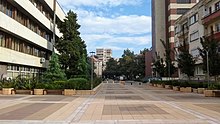Yambol
The ancient Thracian royal city of Kabile or Kabyle (Bulgarian: Кабиле), dating from the end of the 2nd millennium BCE, was located 10 km from current-day Yambol.
The city was conquered by King Philip II of Macedon in 341 BCE and was re-established as an Ancient Greek polis.
By 136 CE, Kabile was one of the largest Roman military bases in the region housing at least 600 soldiers.
A large residence for military officers has recently been excavated in the archaeological park at Kabile.
Prior to the 1945 spelling reform, the name was rendered with an additional yer at the end, as Ямболъ.
It ultimately became part of Bulgaria in 705 CE during the reign of Khan Tervel and has been an important Bulgarian center ever since.
During the reign of Boris I and Tsar Simeon, the first literary centers were established, mostly as part of the church.
During the reign of Tsar Kaloyan, the city again increased in importance, mainly due to the ongoing conflict between Bulgaria and the crusaders.
The Ottomans conquered Yambol in 1373 CE, but a militarized, semi-independent Bulgarian population remained as voyinuks in the southern part of the city.
During World War I, Yambol hosted a base for Luftstreitkräfte (Imperial German Army Air Service) zeppelins used for missions in Romania, Russia, Sudan and Malta.
[13] During the Balkan Wars, Yambol was the headquarters of the First Bulgarian Army, which played a vital role in the defeat of the Turks in Trace.
[15] After this peak, the population started decreasing due to the economic situation in Bulgaria during the 1990s, which led to migration to Burgas.
The museum is a major cultural and information centre which promotes the rich heritage of Yambol and the region.






